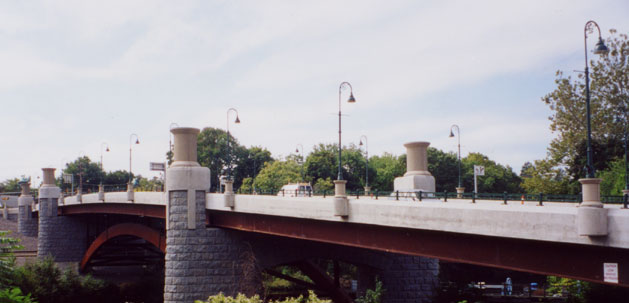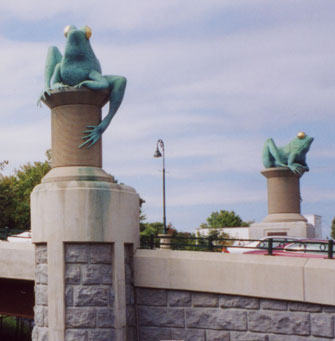Updated Oct 20, 2018
Willimantic's Frog Bridge, officially known as the Thread City Crossing, connects Routes 66 and 32 across the Willimantic River and a rail line. Its distinctive architectural motifs -- four 11-foot frogs atop giant spools of thread -- remind passersby of the city's history, and create a can't-miss landmark.
The four-lane bridge, which opened in 2000, is officially state road 661.
 Frog Bridge, as seen from the northeast (Route 66 side). Don't worry, the frogs are shown in closeup later in the page. Photo taken Sept. 2002 by Kurumi.
Frog Bridge, as seen from the northeast (Route 66 side). Don't worry, the frogs are shown in closeup later in the page. Photo taken Sept. 2002 by Kurumi.
The Frog Bridge replaces an older bridge 900 feet to the east that carried Windham Road (SR 601) from Route 32 across to Route 66. That bridge, built in 1857, is now closed to traffic. It will be converted to pedestrian use, as part of the Heritage State Park at Windham Mills.
In the mid-19th century several cotton mills along the Willimantic River were producing high-quality thread; and the suburbs on the south side needed better access to the borough on the north side. Plans were drawn up in 1872 for a new highway bridge, but none was built. A footbridge built in 1906 served as a compromise for a road bridge defeated in 1904.
In 1986, then-state legislator John Lescoe (now First Selectman) introduced a bill to fund a feasibility study for a new bridge over the Willimantic River. After a late 1980s recession, the funding was approved in 1991. DOT engineers presented a design for the bridge, which residents disparaged as bland. They called for something with more character, a la the famous Merritt Parkway bridges.
After pressure from historians and residents, the state relented and added an architect to the bridge budget, which is not usually done. And the spools of thread decorating the ends of the bridge eventually supported 11-foot frogs.
The bridge's end points are Pleasant Street (Route 32) at South Street, and Main Street (Route 66) at Jackson Street. (There was once a proposal to reroute Route 195 along Jackson Street, so the Frog Bridge might have become the final few hundred feet of Route 195.) Work began March 1999, and the new bridge opened in early September 2000. The entire project finished in fall 2001.
In the words of contractor O & G Industries, the Frog Bridge shows off architectural ancillaries, "which exemplify some of the town's history, include arched weathering steel, simulated stone masonry finishes, decorative light standards, luminaries, a metal bridge rail, precast concrete thread spools and four bronze frog statues."
In 2002, the Federal Highway Administration awarded the Frog Bridge an Honorable Mention for Excellence in Highway Design, in the category of Historic Preservation.
 Two rather menacing-looking frogs look north from the bridge, wondering which pedestrians might be good for breakfast. Photo taken Sept. 2002 by Kurumi.
Two rather menacing-looking frogs look north from the bridge, wondering which pedestrians might be good for breakfast. Photo taken Sept. 2002 by Kurumi.
Willimantic is well-known as the Thread City.... but whassup with the Frog Bridge? This harks back to the legend of the Frog Fight, a harrowing night in 1754 when townspeople rushed outside with their muskets to defend themselves from an unseen screeching menace. The next morning, they discovered scores of dead frogs, who had fought for the last remaining puddles of water in a drought-stricken lake.
The frogs have catapulted the bridge to the forefront of American roadside kitsch. Bill Griffith even devoted a "Zippy the Pinhead" comic strip to the bridge in June 2001. "All right, let's cut to the chase... You're big, you're green, you're from Willimantic... what do you want?"
In early 2004, advocates were pressing for progress on the "Garden on the Bridge", a $560,000 proposal that would add flowers, plantings and a pedestrian path on the old bridge, now closed to traffic.
The project was inspired by the "Bridge of Flowers", a former trolley bridge in Shelburne Falls, Mass. Thousands of tourists each year are said to visit this bridge.
(The Willimantic Chronicle article on this subject mentions taking ownership of SR 601, but that highway has already been deleted from the state system.)